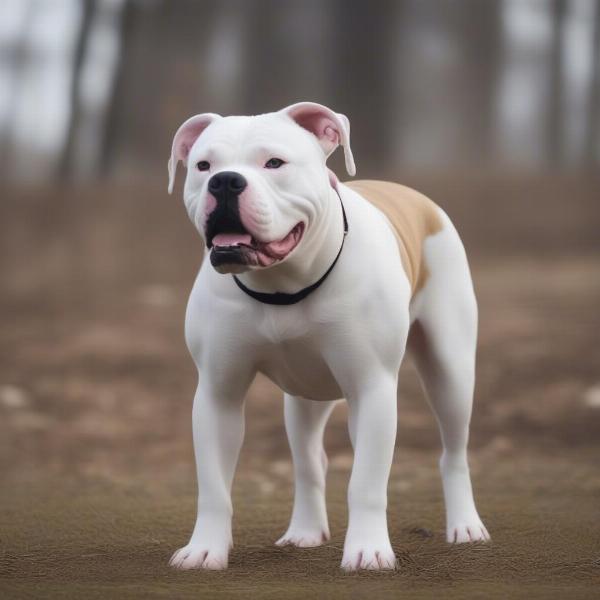Pit bulls are a controversial breed, often misunderstood and misidentified. Many breeds share similar physical characteristics, leading to confusion and sometimes, unfair prejudice. Understanding these “pit bull look-alikes” is crucial for responsible pet ownership and combating breed-specific legislation. This article will explore various breeds commonly mistaken for pit bulls, highlighting their unique traits and helping you differentiate them from true pit bull breeds.
Decoding the “Pit Bull” Label
The term “pit bull” itself isn’t a breed, but rather a generic term often used to describe several breeds with similar physical characteristics like a broad head, muscular build, and short coat. These breeds typically include the American Pit Bull Terrier, American Staffordshire Terrier, Staffordshire Bull Terrier, and sometimes the American Bully. This ambiguity contributes to the misidentification problem. So, which breeds are often caught in the crossfire?
Breeds Often Confused with Pit Bulls
Several breeds are frequently misidentified as pit bulls due to shared physical traits. Let’s delve into some of the most common ones:
The American Bulldog
American Bulldogs, known for their stocky build and powerful jaws, are often mistaken for pit bulls. However, they are generally larger and have a less pronounced stop (the indentation between the forehead and muzzle). Their temperament tends to be more protective and less prone to dog aggression compared to some pit bull types.
 American Bulldog Often Mistaken for Pitbull
American Bulldog Often Mistaken for Pitbull
The Boxer
Boxers, with their muscular physique and brachycephalic (short-nosed) features, can sometimes be mistaken for pit bulls. However, their playful and energetic nature sets them apart. Boxers are typically known for their affectionate and goofy personalities. Their distinct wrinkled forehead and often cropped ears also differentiate them.
The Staffordshire Bull Terrier
While a member of the pit bull family, the Staffordshire Bull Terrier is often confused with the American Pit Bull Terrier. “Staffies” are typically smaller and stockier than their American counterparts. While they can be protective, they are generally known for their affection towards humans, especially children.
The American Bully
The American Bully, a relatively new breed, was developed from American Pit Bull Terriers and other bulldog-type breeds. They come in various sizes, some of which are significantly larger than the average pit bull. While they share some physical traits, the American Bully’s temperament is generally described as gentle and friendly.
Why Correct Identification Matters
Accurate breed identification is essential for numerous reasons. It helps avoid misinformed judgements based on breed stereotypes, prevents the implementation of ineffective breed-specific legislation, and allows for responsible breeding practices. Understanding the nuances of each breed also helps owners tailor training and socialization to meet their dog’s specific needs.
What to Do If You’re Unsure of a Dog’s Breed
If you’re unsure about a dog’s breed, consulting with a veterinarian, a reputable breeder, or a professional dog trainer can provide valuable insights. DNA testing is another option that can offer a definitive answer and help clarify any uncertainties.
Conclusion
While many breeds share physical similarities with pit bulls, understanding their unique characteristics helps differentiate them and avoid misidentification. This knowledge is crucial for responsible pet ownership, combats prejudice, and promotes a more informed perspective on these often misunderstood dogs. By appreciating the individuality of each breed, we can move beyond harmful stereotypes and celebrate the diverse world of canine companions.
FAQ
- Are all “pit bull type” dogs aggressive? No, temperament is influenced more by individual factors and upbringing than by breed alone.
- How can I tell the difference between an American Bulldog and a Pit Bull? American Bulldogs are generally larger with a less pronounced stop.
- Are Boxers related to Pit Bulls? While both are brachycephalic breeds, they are not directly related.
- Is DNA testing reliable for breed identification? Yes, DNA testing is considered the most accurate method for determining a dog’s breed.
- What should I do if someone misidentifies my dog as a Pit Bull? Politely educate them about the dog’s actual breed and dispel any misconceptions.
- Do all “pit bull type” dogs have the same needs? While there may be some overlap, each breed has unique needs and temperaments requiring tailored care.
- Where can I learn more about responsible dog ownership? Reputable breeders, trainers, and veterinary professionals are excellent resources.
About ILM Dog
ILM Dog is your trusted international resource for all things dog-related. We provide expert advice on dog breeds, health, training, nutrition, grooming, and much more. Whether you’re a seasoned dog owner or just starting your journey, ILM Dog offers valuable insights and practical tips to help you provide the best possible care for your canine companion. For further assistance or inquiries about our services including breed selection, health and wellness, and training and behavior, contact us at [email protected] or call us at +44 20-3965-8624. Visit ILM Dog today to learn more!